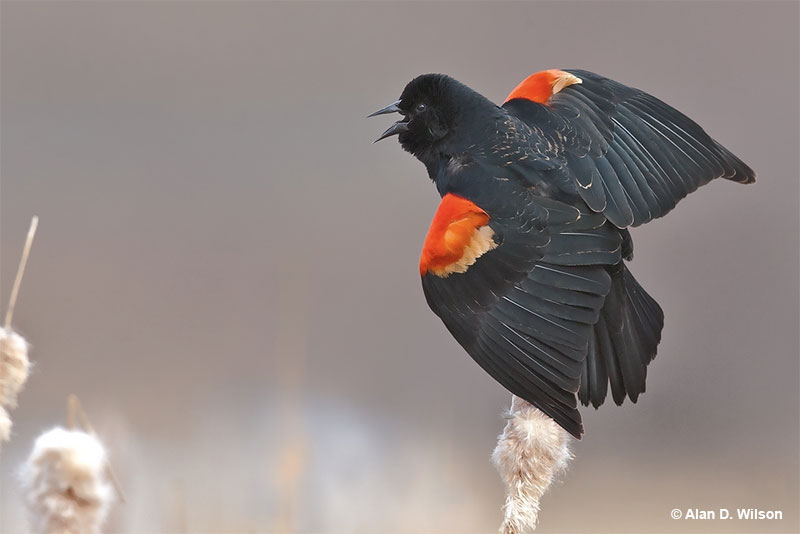The Red-winged Blackbird (Agelaius phoeniceus) is one of the most plentiful birds in North America.
They can be found throughout almost all of the United States year-round and parts of Mexico.
On this page
Identification
Red-winged Blackbirds are broad-shouldered, stocky blackbirds. They have medium-length tails and conical, slender bills. When perched, Red-winged Blackbirds have a hump-backed silhouette.
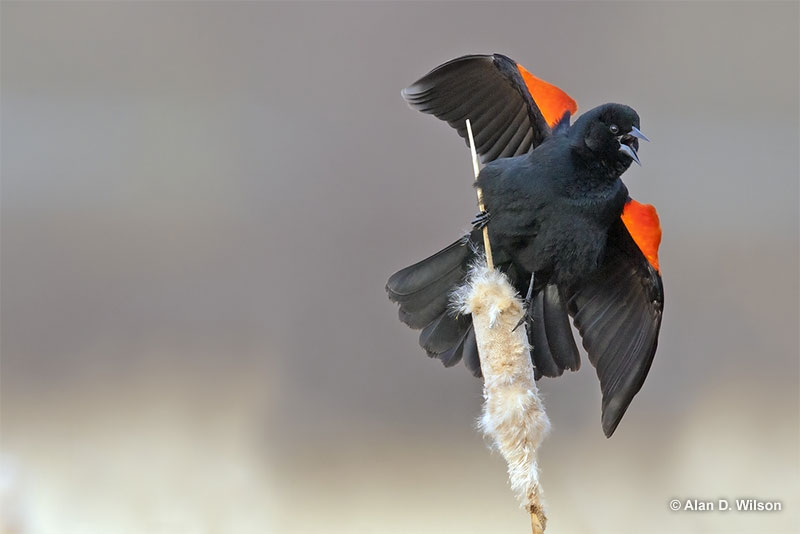
Additionally, males will usually sit with their tails slightly flared. Both males and females are the same size. They are 6.7 to 9.1 inches long, weigh 1.1 to 2.7 ounces, and have a wingspan that ranges from 12.2 to 15.8 inches.
Male Red-winged Blackbirds are striking, which makes them hard to mistake. They are primarily glossy black and have red-and-yellow shoulder patches. Female Red-winged Blackbirds are dark brown overall and have clean streaks. They’re paler on their breasts and have whitish eyebrows.
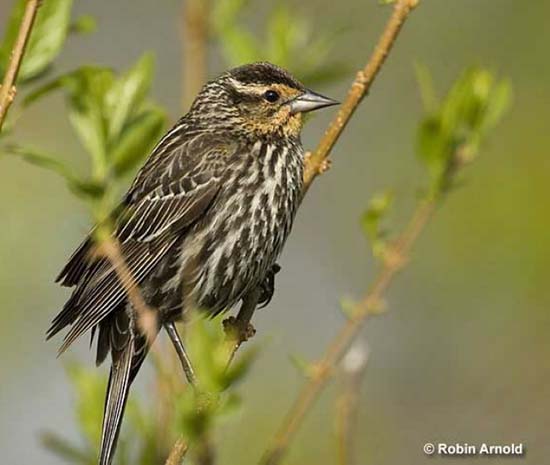
Female Red-winged Blackbird
There’s a slight regional difference for Red-winged Blackbirds across the country, but the most notable difference is on birds that live in coastal California. The California variation, also known as the “bicolored blackbird,” has no yellow border on the red patch.
Food
Red-winged Blackbirds have a diet that mostly consists of insects and seeds. They feed mostly on insects in the summer and seeds in the winter.
Common foods they eat during the summer are grasshoppers, beetles, spiders, caterpillars, millipedes, and snails.
The majority of adult Red-winged Blackbird diets consist of seeds, including weeds, waste grain, and grasses. They’ve also been known to eat berries and other small fruits.
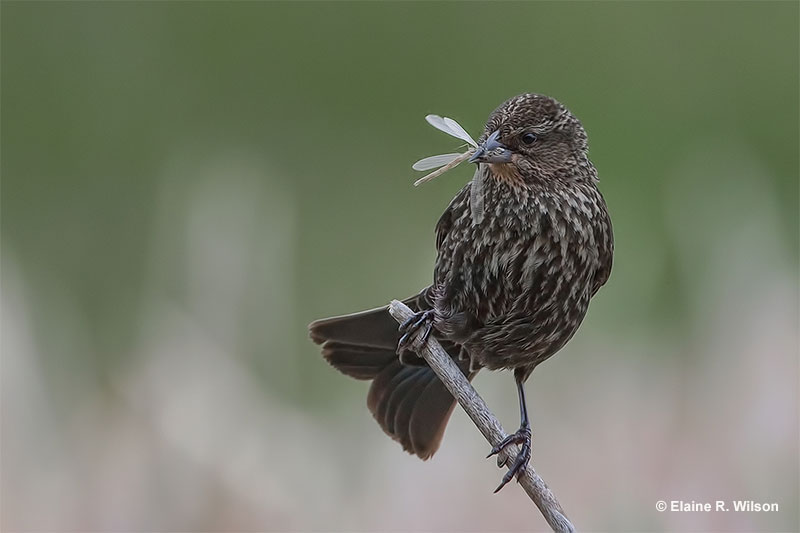
Red-winged Blackbirds can also sometimes be seen feeding at the bases of aquatic plants by probing them with their bills. Doing this preys the vegetation open so they can get to the insects inside. In the cooler months, they’ll eat ragweed, cocklebur, waste grains, and native sunflowers.
Related: Are blackbirds good or bad omens?
Red-winged Blackbirds will eat from bird feeders. They prefer black oil sunflower seeds, hulled sunflower seeds, and seed mixes, including corn, sunflower seeds, peanut hearts, and milo seed.
Nesting and Eggs
Red-winged Blackbirds prefer to build their nests low amongst trees, vertical marsh vegetation, or shrubs. Female Red-winged Blackbirds are the ones that choose the nesting site with limited input from the male.
Usually, she’ll put the nest near the ground in dense, grass-like vegetation. This could be bulrushes, cattails, sedges, and Phragmites. She’ll place them in wetlands in blackberry, goldenrod, willow, and alder trees. The female Red-winged Blacbird utilizes barley, wheat, rice, and alfalfa plants in uplands.
Female Red-winged Blackbirds build the nest as well. She’ll use stringy plant material to bend around several upright, close stems. Additionally, she’ll weave in a platform of wet, course vegetation.
She’ll continue to add materials like decayed wood and wet leaves and plaster the inside of the nest with mud to make an interior cup.
Finally, she’ll line the cup with dry, fine grasses. When finished, the nest is 3 to 7 inches deep and 4 to 7 inches wide.
Red-winged Blackbirds can have 1 to 2 broods per year, and the size of the clutch can vary from 2 to 4 eggs. They incubate the eggs for around 12 days, after which the young stay in the nest for up to two weeks,
Current Situation
Red-winged Blackbirds like to breed in wet places like rice paddies and salt or freshwater marshes. However, while they prefer to breed in wet areas, that doesn’t mean they can’t be seen breeding in drier places like alfalfa fields, fallow fields, and sedge meadows.
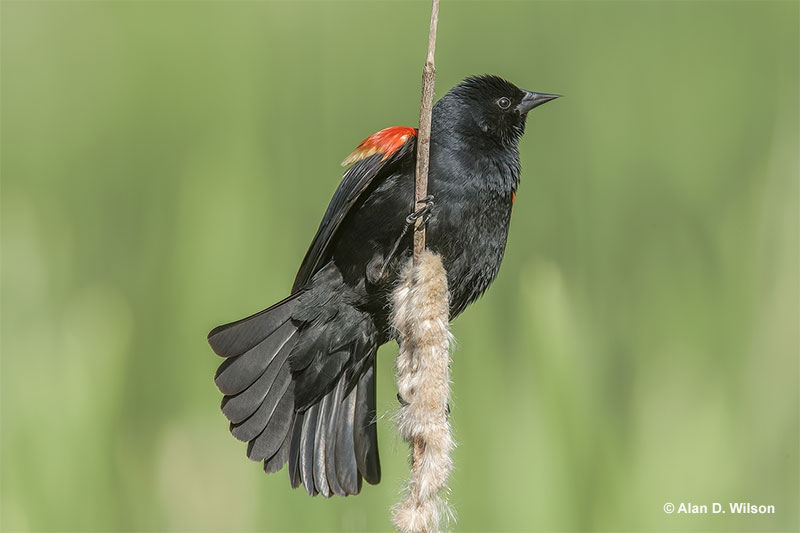
On occasion, Red-winged Blackbirds will nest along waterways in wooded areas. In the fall and winter, Red-winged Blackbirds gather in feedlots, agricultural fields, grassland, and pastures in the fall and winter.
Even though Red-winged Blackbirds are one of the most plentiful birds in North America, their populations have declined by around 0.72 per year between 1966 and 2019. This gives them an estimated population decline of 28%.
Their estimated population is 180 million, that’s down 10,000,000 since 1974. According to the IUCN Red List, they have a decreasing population and are a species of least concern.
Facts
- An experiment was conducted to see if genetic makeup or environment caused such a significant change in proportions and size when it comes to different subspecies and populations of Red-winged Blackbirds. For this experiment, scientists moved nestlings between Red-winged Blackbird populations and found that the nestlings grew up to resemble their foster parents. This solidifies the belief that nestlings grew based on their environment, not genetic makeup.
- Male Red-winged Blackbirds will aggressively defend their territories during the breeding season. They’ll spend more than a quarter of the day defending their territory. He’ll attack nest predators and chase other males out of his territory. They’ve even been known to go after more significant threats like people and even horses!
- There’s a slight regional difference for Red-winged Blackbirds across the country, but the most notable difference is on birds that live in coastal California. The California variation, also known as the “bicolored blackbird,” has no yellow border on the red patch. It’s theorized that this difference in plumage may help these birds recognize each other and where their range overlaps with similar-looking birds.
Similar Species
The Red-winged Blackbird has features that are similar to other bird species. Here are some similar species:
Song Sparrow
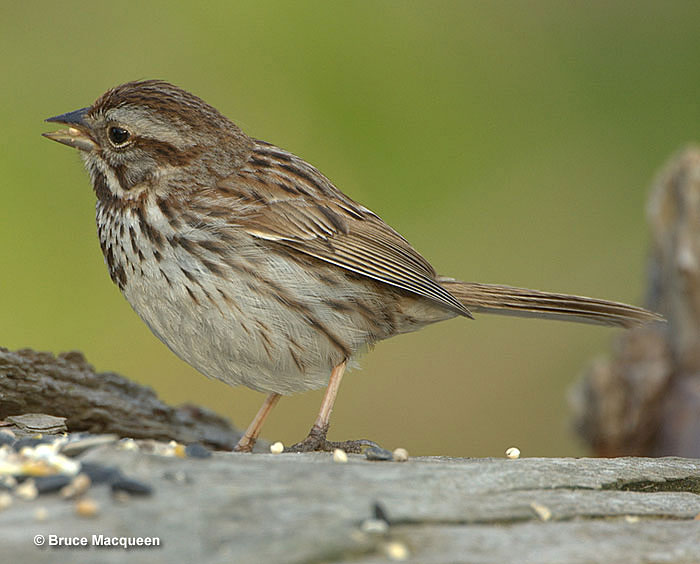
Female Red-winged Blackbirds and Song Sparrows can be easily mistaken for one another because of their light brown color and streaks.
However, these birds have shorter tails, are smaller overall, and have thicker, shorter bills.
Tricolored Blackbird
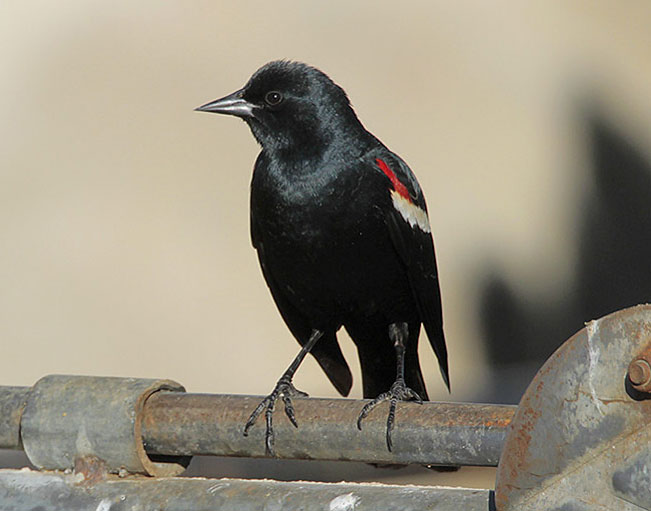
Red-winged Blackbirds overlap with Tricolored Blackbirds in California.
Male Red-winged Blackbirds can be discerned from Tricolored Blackbirds from the less glossy plumage and yellow border on the shoulder. Tricolored Blackbirds have a white border.
Female Red-winged Blackbirds have more streaking and are warmer brown. Female Tricolored Blackbirds are a colder charcoal gray.
Frequently Asked Questions
How rare is a Red-winged Blackbird?
Red-winged Blackbirds are not rare. In fact, they’re one of the most plentiful birds in North America.
What is the difference between a male and female Red-winged Blackbird?
Male Red-winged Blackbirds are mostly glossy black and have red-and-yellow shoulder patches. Female Red-winged Blackbirds are dark brown overall and have clean streaks. They’re paler on their breasts and have whitish eyebrows.
What are the greatest risks to the Red-winged Blackbird?
The greatest threats to Red-winged Blackbirds are habitat loss and pesticides. Habitat loss can happen from development and agriculture as well as drainage of wetlands. In addition, like a lot of other birds, red-winged blackbirds are at risk of ingesting pesticides due to them getting in the food chain.
Are Red Wing Blackbirds aggressive?
Yes, Red-winged Blackbirds can be aggressive. These birds will attack anything that comes close to their nests. It doesn’t matter the risk of danger or the size of the threat.
Are Red-winged Blackbirds pests?
Some consider Red-winged Blackbirds pests because they eat grain in cultivated fields. However, farmers also benefit from these birds visiting their fields because they eat insects that are harmful to the plants during their nesting season.
Do Red-winged Blackbirds migrate?
Yes, some populations of Red-winged Blackbirds migrate while others do not. In addition, some Western and Southern populations don’t migrate at all.

